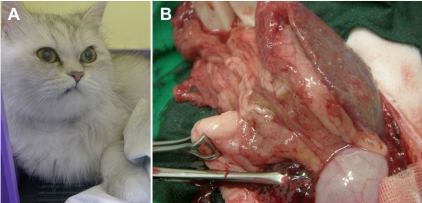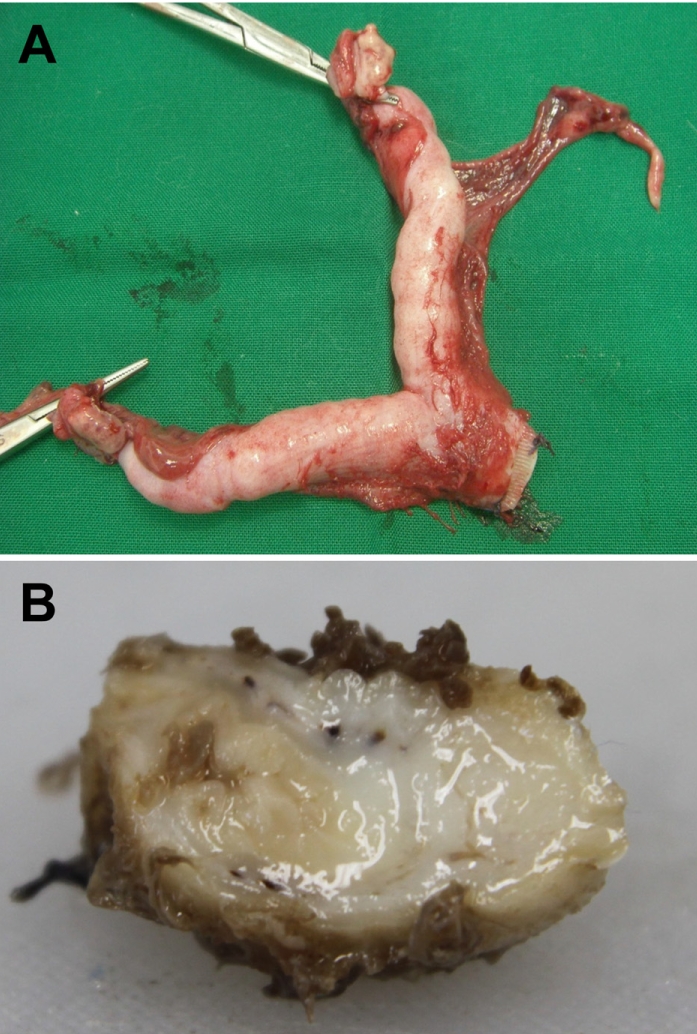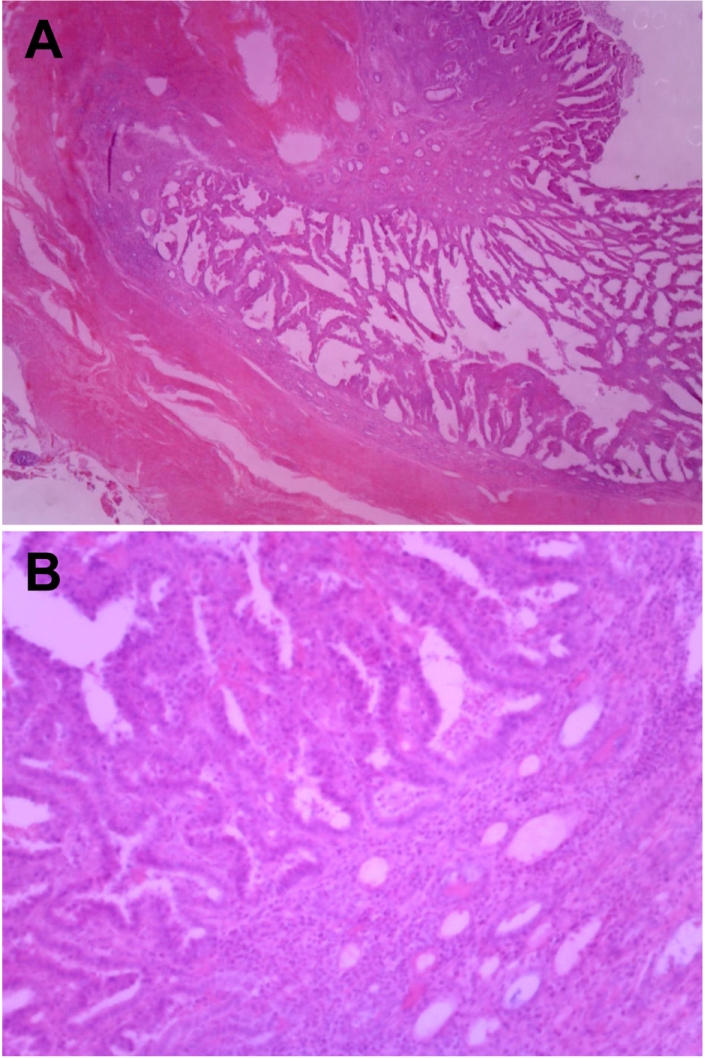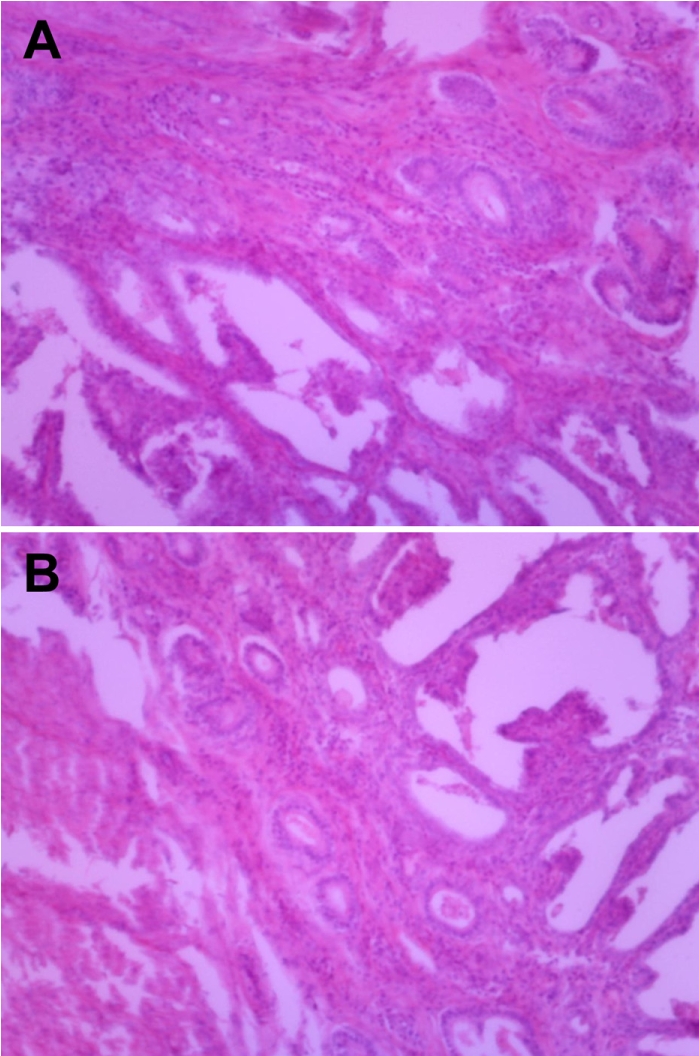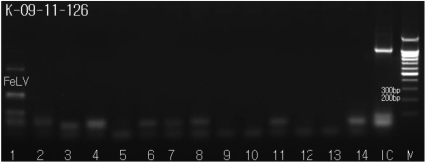Lab Anim Res.
2011 Dec;27(4):347-351. 10.5625/lar.2011.27.4.347.
Uterine adenocarcinoma with feline leukemia virus infection
- Affiliations
-
- 1Center for Animal Resources Development, Wonkwang University, Iksan, Korea.kimoj@whu.ac.kr
- 2Family Animal Clinic, Gunsan, Korea.
- 3Institute of Biotechnology, Wonkwang University, Iksan, Korea.
- KMID: 1444969
- DOI: http://doi.org/10.5625/lar.2011.27.4.347
Abstract
- Feline endometrial adenocarcinomas are uncommon malignant neoplasms that have been poorly characterized to date. In this study, we describe a uterine adenocarcinoma in a Persian cat with feline leukemia virus infection. At the time of presentation, the cat, a female Persian chinchilla, was 2 years old. The cat underwent surgical ovariohystectomy. A cross-section of the uterine wall revealed a thickened uterine horn. The cat tested positive for feline leukemia virus as detected by polymerase chain reaction. Histopathological examination revealed uterine adenocarcinoma that had metastasized to the omentum, resulting in thickening and the formation of inflammatory lesions. Based on the histopathological findings, this case was diagnosed as a uterine adenocarcinoma with abdominal metastasis. To the best of our knowledge, this is the first report of a uterine adenocarcinoma with feline leukemia virus infection.
Keyword
MeSH Terms
Figure
Reference
-
1. Kennedy PC, Cullen JM, Edwards JF, Goldschmidt MH, Larsen S, Munson L, Nielsen S. Cullen JM, editor. Tumors of the uterus. Histological Classification of Tumors of the Genital System of Domestic Animals. 1998. 2nd ed. Washington DC: Armed Forces Institute of Pathology;p. 32–33.2. Elsinghorst TA, Timmermans HJ, Hendriks HG. Comparative pathology of endometrial carcinoma. Vet Q. 1984; 6(4):200–208. PMID: 6388139.
Article3. Deerberg F, Rehm S, Pitterman W. Uncommon frequency of adenocarcinomas of the uterus in virgin Han:Wistar rats. Vet Pathol. 1981; 18(6):707–713. PMID: 7292893.
Article4. Stabenfeldt GH, Pedersen NC. Pedersen NC, editor. Reproduction and reproductive disorders. Feline Husbandry: Diseases and Management in the Multiple-Cat Environment. 1991. Goleta: American Veterinary Publications Inc;p. 129–162.5. Anderson MC, Robboy SJ, Russell P, Morse A. Robboy SJ, editor. Endometrial carcinoma. Pathology of the Female Reproductive Tract. 2002. London: Churchill Livingstone;p. 331–359.6. De-The G. Hiatt HH, editor. Viruses as causes of some human tumors? Results and prospectives of the epidemiologic approach. Origins of Human Cancer. 1977. Cold Spring Harbor: Cold Spring Harbor Laboratory;p. 1113–1131.7. Arjona A, Barquero N, Domenech A, Tejerizo G, Collado VM, Toural DM, Gomez-Lucia E. Evaluation of a novel nested PCR for the routine diagnosis of feline leukemia virus (FeLV) and feline immunodeficiency virus (FIV). J Feline Med Surg. 2007; 9(1):14–22. PMID: 16863698.8. Daniels MJ, Golder MC, Jarret O, MacDonald DW. Feline viruses in wildcats from Scotland. J Wildl Dis. 1999; 35(1):121–124. PMID: 10073361.
Article9. Khan KNM, Kociba GJ, Wellman ML. Macrophage tropism of feline leukemia virus (FeLV) of subgroup-C and increased production of tumor necrosis factor-α by FeLV-infected macrophages. Blood. 1993; 81(10):2585–2590. PMID: 8387834.10. Cattori V, Tandon R, Pepin A, Lutz H, Hofmann-Lehmann R. Rapid detection of feline leukemia virus provirus integration into feline genomic DNA. Mol Cell Probes. 2006; 20(3-4):172–181. PMID: 16488115.
Article11. Simons FA, Vennemac H, Rofinab JE, Pold JM, Horzineke MC, Rottiera PJM, Egberinka HF. A mRNA PCR for the diagnosis of feline infectious peritonitis. J Virol Methods. 2005; 124(1-2):111–116. PMID: 15664058.
Article12. English RV, Kershaw O, Kempf VA, Gruber AD. In vivo lymphocyte tropism of feline immunodeficiency virus. J Virol. 1993; 67(9):5175–5186. PMID: 7688819.13. Buchmann AU, Kershaw O, Kempf VAJ, Gruber AD. Does a feline leukemia virus infection pave the way for Bartonella henselae infection in cats? J Clin Microbiol. 2010; 48(9):3295–3300. PMID: 20610682.14. Reubel GH, Ramos RA, Hickman MA, Rimstad E, Hoffmann DE, Pedersen NC. Detection of active and latent feline herpesvirus 1 infections using the polymerase chain reaction. Arch Virol. 1993; 132(3-4):409–420. PMID: 8397503.
Article15. Sykes JE, Allen JL, Studdert VP, Browning GF. Detection of feline calicivirus, feline herpesvirus 1 and Chlamydia psittaci mucosal swabs by multiplex RT-PCR/PCR. Vet Microbiol. 2001; 81(2):95–108. PMID: 11376956.
Article16. Xie DH, Zhu XQ, Cui HL, Qiu CJ, Fan WH, Liao SQ, Zhai ML, Lin RQ, Weng YB. Development of a PCR assay for diagnosing swine toxoplasmosis. Chin J Vet Sci Technol. 2005; 35(4):289–293.17. Simking P, Wongnakphet S, Stich RW, Jittapalapong S. Detection of Babesia vogeli in stray cats of metropolitan Bangkok, Thailand. Vet Parasitol. 2010; 173(1-2):70–75. PMID: 20638794.18. Aktas M, Altay K, Dumanli N, Kalkan A. Molecular detection and identification of Ehrlichia and Anaplasma species in ixodid ticks. Parasitol Res. 2009; 104(5):1243–1248. PMID: 19247690.
Article19. Cooper SK, Berent LM, Messick JB. Competitive, quantitative PCR analysis of Haemobartonella felis in the blood of experimentally infected cats. J Microbiol Methods. 1999; 34(3):235–244.20. Tijsse-Klasen E, Fonville M, Reimerink JH, Spitzen-van der Sluijs A, Sprong H. Role of sand lizards in the ecology of Lyme and other tick-borne diseases in the Netherlands. Parasit Vectors. 2010; 3:42. PMID: 20470386.
Article21. Romero C, Gamazo C, Pardo M, López-Goñi I. Specific detection of Brucella DNA by PCR. J Clin Microbiol. 1995; 33(3):615–617. PMID: 7538508.
Article22. Klein MK. Withrow SJ, editor. Tumors of the female reproductive system. Small Animal Clinical Oncology. 2001. Philadelphia: WB Saunders;p. 445–454.
Article23. MacLachlan NJ, Kennedy PC. Meuten DJ. Tumors of the genital system. Tumors in Domestic Animals. 2002. Ames: Iowa State Press;p. 547–573.24. Kim KS, Kim O. Cystic endometrial hyperplasia and endometritis in a dog following prolonged treatment of medroxyprogesterone acetate. J Vet Sci. 2005; 6(1):81–82. PMID: 15785129.
Article25. Munson L, Gardner IA, Mason RJ, Chassy LM, Seal US. Endometrial hyperplasia and mineralization in zoo felids treated with melengestrol acetate contraceptives. Vet Pathol. 2002; 39(4):419–427. PMID: 12126144.
Article26. Pazol K, Wilson ME, Wallen K. Medroxyprogesterone acetate antagonizes the effects of estrogen treatment on social and sexual behavior in female macaques. J Clin Endocrinol Metab. 2004; 89(6):2998–3006. PMID: 15181090.
Article27. Cotter SM. Feline leukemia virus: Pathophysiology, prevention, and treatment. Cancer Invest. 1992; 10(2):173–181. PMID: 1312884.
Article28. Hardy WD, Old LJ, Hess PW, Essex M, Cotter SM. Horizontal transmission of feline leukemia virus. Nature. 1973; 244(5414):266–269. PMID: 4147636.29. Francis DP, Essex M, Hardy WD. Excretion of feline leukemia virus by naturally infected pet cats. Nature. 1977; 269(5625):252–254. PMID: 201852.30. Azocar J, Essex M. Susceptibility of human cell lines to feline leukemia virus and sarcoma virus. J Nat Cancer Inst. 1979; 63(5):1179–1184. PMID: 228103.31. Essex M, McLane MF, Kanki P, Allan J, Kitchen L, Lee TH. Retroviruses associated with leukemia and ablative syndromes in animals and in human beings. Cancer Res. 1985; 45(9 Suppl):4534s–4538s. PMID: 2990682.
- Full Text Links
- Actions
-
Cited
- CITED
-
- Close
- Share
- Similar articles
-
- A simultaneous occurrence of feline mammary carcinoma and uterine cystic endometrial hyperplasia in a cat
- Status of selected feline infectious diseases in Gwangju, Korea
- Evaluation of expression patterns of feline CD28 and CTLA-4 in feline immunodeficiency virus (FIV)-infected and FIV antigen-induced PBMC
- Acute monoblastic leukemia in a FeLV-positive cat
- Incidence and sero-surveillance of feline viruses in Korean cats residing in Gyeonggi-do

